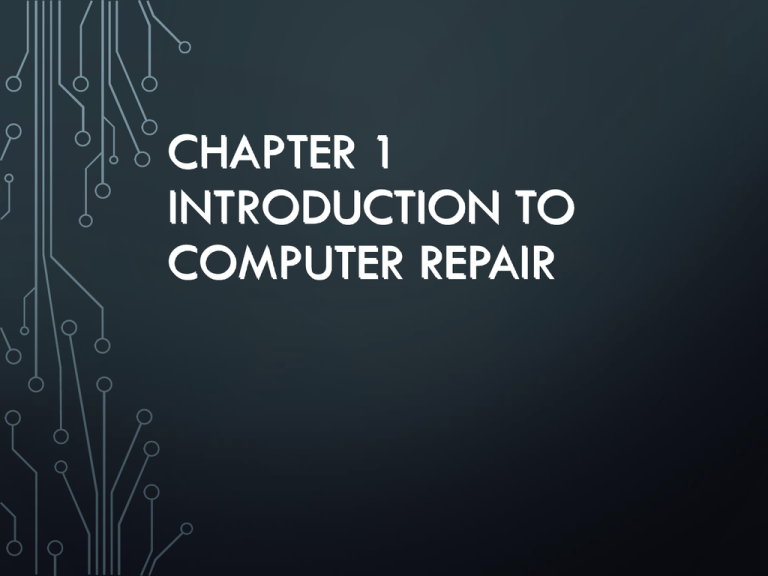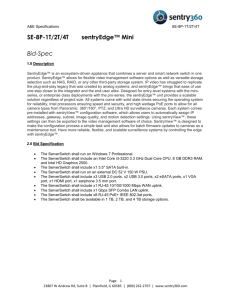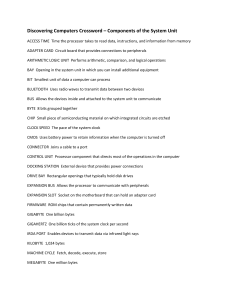
CHAPTER 1
INTRODUCTION TO
COMPUTER REPAIR
CERTIFICATIONS
• Certifications
•
•
•
•
May substitute for experience
May get them an interview
Shows they know the basic information for the job
Does not demonstrate ability to think logically, troubleshoot
problems, or deal with people in a professional manner
• Validates experienced technicians proficiency and up-to-date
knowledge
A+ CERTIFICATION & COMP TIA
•
•
•
Computing Technology Industry Association (CompTIA)
•
The A+ Certification is a non-vendor specific industry standard
certification.
Created in 1982 from representatives of five microcomputer dealerships.
The A+ certification demonstrates competency as a computer technician.
They have many more certifications
•
•
•
Does not guarantee someone a job
Is required by a lot of companies and agencies
Consists of two exams
•
•
220-701 A+ Essentials
220-702 IT Technician
•
CompTIA states that it measures competencies for an IT professional with at least 1000
hours of hands-on experience in the lab or field.
PRELIMINARY SAFETY NOTES
Computer Power
Turn off and unplug the
computer when taking
the computer apart,
installing parts,
removing parts, or
performing preventive
maintenance.
Power Supply
and CRT Monitor
Do not take these
components apart without
specific training. They
hold a charge and can
hurt you.
OVERVIEW
Qualities
Parts
Ports
Explore qualities of a good
computer support person
Discover the major parts of the
computer
Identify ports seen on a computer
© 2012 Pearson Addison-Wesley. All rights reserved.
A GOOD TECHNICIAN…
Technician Qualities
Active
listening
Good,
positive
attitude
© 2012 Pearson Addison-Wesley. All rights reserved.
Know
technical
terms, but
explain in
easy to
understand
words
Humbleness
TRAITS OF A TECH
• Dependable
• Responsible
• Adapt
• Versitle
• Sensitive
SAFETY OF THE COMPUTER
• Electrostatic Discharge
• Anti-Static Tools
• Wrist strap
• Anti-static mat
• Anti-static bag
• And don’t drop the computer!
BEGINNING TERMS
Hardware
The physical components
•Case, keyboard, power supply, mouse
Software
Operating systems such
as Windows 7, Red Hat
Linux, Snow Leopard
Applications such as
Adobe Acrobat and
Microsoft PowerPoint
Firmware
A combination of hardware and software such as chips on an adapter
(hardware) that contain software to control and customize the adapter or the
BIOS on the motherboard.
HARDWARE AND SOFTWARE INTERACTION
• Notice how the operating system
communicates with hardware through
the kernel and the operating system.
• Another way the operating system
communicates with hardware is
directly through the BIOS (which is not
shown).
• This is especially important for integrated
components inside the computer.
•
What’s the BIOS?
HOW THE PC WORKS
• Interaction of RAM, Processor and Hard-Drive
• What does the OS do?
•
•
•
•
•
•
Memory management
File management
Process management
What is a device driver?
User Interface
Utilities
BASIC COMPUTER PARTS
BASIC COMPUTER PARTS
BASIC LAPTOP PARTS
BASIC LAPTOP PARTS
DC power port
Media bay
BASIC MOTHERBOARD PARTS
OTHER MAJOR PARTS
• Motherboard
•
•
•
•
RAM
Flash memory
Expansion slots
• Memory
• RAM (Random Access
Memory)
•
Adapters
Volatile or contents are
gone if power is
removed
• ROM (Read Only Memory)
•
Contents cannot be
changed
• Stores less than hard drives
© 2012 Pearson Addison-Wesley. All rights reserved.
BASIC PORTS
DINs are
notched/
keyed
D-shell connectors are
shaped like the letter D
turned to the right.
DB-25 (parallel)
DB-9 (serial)
DB-15 (game)
VIDEO PORTS
•
DVI
•
•
•
Flat panel monitors, LCDs
S-Video
•
TVs, VCRs, cameras,
external video devices
•
2 channel video
VGA
•
•
Older CRT monitors
Lowest common
denominator for all video
cards
USB PORTS
• 127 devices on a single port
• But your OS/controller may not support
127 devices !!
• 1.0
•
•
•
•
• 1.5 and 12Mbps
2.0
• Plus sign (+)
• 480Mbps
3.0
• SS (SuperSpeed)
• 5Gbps
Mini versions available
Converters of all types are
available
USB “MINI” CONNECTORS
• Common on
• Cameras
• Digital media readers
• External hard drives
• Three types
• Mini-A
• Mini-B
• Mini-AB
Mini-B USB
Connector
PARALLEL PORT
• Also known as a printer port
• DB-25 (25-pin) female port
• Replaced by USB
• Transmits data 8 bits at a time
SERIAL PORT
• Also known as a COM, RS-232, or asynchronous port
• DB-9 (9-pin) male port and an older DB-25 male port
• Replaced by USB (Actually also serial transmission)
• Transmits data 1 bit
at a time
• If a serial port is needed such as
to configure a router, a USB to
serial converter can be purchased.
• This is not a simple converter but requires a device
and driver
KEYBOARDS AND MICE
• Wired
• Mini-DIN or PS/2 port (not interchangeable)
• USB port
• Wireless
• Bluetooth
• RF
• Mouse types
• Mechanical (rubber ball)
• Optical (LEDs)
• Keyboard types
• Mechanical
• Cheaper, most common, more error-prone
• Capacitive
• More complex design
Mouse
Keyboard
PREVENTIVE MAINTENANCE
• Mouse
•
•
•
Cleaning kits
Optical: damp, lint-free cloth for the bottom
Mechanical mouse ball: clean with mild detergent, rinse, and dry
thoroughly. For rollers, lint-free cloth with alcohol; otherwise, fingernail,
small screwdriver, straightened paper clip.
• Keyboard
•
•
•
•
Cleaning wipes
Compressed air
Cotton or lint-free swab between keys
Upside down shake
WIRELESS INPUT DEVICES
• Infrared
•
•
• Shorter distances and cheaper
Radio
• Interferences from other devices
Troubleshooting
• Battery
• Line of site with infrared
• Move device or transceiver
• Interference
• Device recognized by operating system
OTHER INPUT DEVICES
SOUND CARD PORTS
• Converts digital signals to sound (analog signal) and vice versa
• Can be on the motherboard or on an adapter
SOUND CARD PORTS
• Commonly have symbols that designate the purpose of the port
• Standardized colors
•
•
•
•
•
•
Orange – Center speaker or subwoofer
Black – Rear speaker
Light blue – Line in
Lime – Line out
Pink – Microphone
Gray – Side speaker
IEEE 1394 PORT
• 63 devices can connect to a single port (using hubs)
• Speeds of 100, 200, 400, 800, 1600, and 3200Mbps
• Also called FireWire or i.Link
• Faster than USB
• Supports hot swapping
IEEE 1394 PORT
• 4-, 6-, and 9-pin connectors
• 4-pin on consumer electronics
• 6-pin on computers
• 9-pin used on 800Mbps connections
• Newer standards support RJ-45 and fiber connectors
6-pin
4-pin
9-pin
NETWORK PORTS
• Connects a computer to other computers, a network, which could
include a server and a printer among other devices.
• Two types
• Ethernet
•
•
Most common type
RJ-45 port
• Token Ring
•
Not very
common
ETHERNET PORTS
• Most common
• Types
• BNC (old)
• 15-pin female D-shell (old)
• RJ-45
• Connects to UTP cable
MODEM PORTS
• A modem connects a computer to a phone line.
• Has one or two RJ-11 ports
• A modem can be an adapter or an external device.
• The adapter has two connectors for connecting the phone
cables.
• Line port has a cable that goes to the phone jack on the wall.
• Phone port has a cable that connects to a telephone.
• An external modem connects to a serial port.
• Phone cables use the same ports as the internal modem.
INTEGRATED MOTHERBOARDS
MiniIEEE
RJ-45
Optical IEEE
1394
NIC
S/PDIF 1394 (FireWire)
RJ-45
NIC
Mouse
6 audio
ports
Line in
Line out
Keyboard
Microphon
Coax
S/PDIF
2 USB
ports
2 USB
ports
2 USB
ports
2 USB
ports
Center speaker
Rear speaker
Side speaker
PROS OF INTEGRATED MOTHERBOARDS
Saves on the
number of
expansion
slots needed
or used
Easier to
troubleshoot
and support
Gets data to the
port faster than
if the port was
on an adapter
© 2012 Pearson Addison-Wesley. All rights reserved.
CONS OF INTEGRATED MOTHERBOARDS
You have to add
an adapter or
replace the
motherboard.
What if there is
not an available
slot?
© 2012 Pearson Addison-Wesley. All rights reserved.
May have
ports you
don’t need or
want
The port may
not be as high
a quality as
an adapter
you might buy
DOCKING STATION
• A docking station allows a laptop to be more like a desktop
computer.
• Commonly has connections to a monitor, printer, keyboard, and mouse
PORT REPLICATOR
• Similar to a docking station
• Does not include any expansion slots or drive storage
bays.
• Attaches to the laptop and allows external devices such as
monitor, keyboard, and mouse to be connected.
• A port replicator is for quick & easily taking your laptop
on the go, a dock station is to make it like a desktop
computer
PORT ROUND-UP
© 2012 Pearson Addison-Wesley. All rights reserved.
QUESTIONS???







